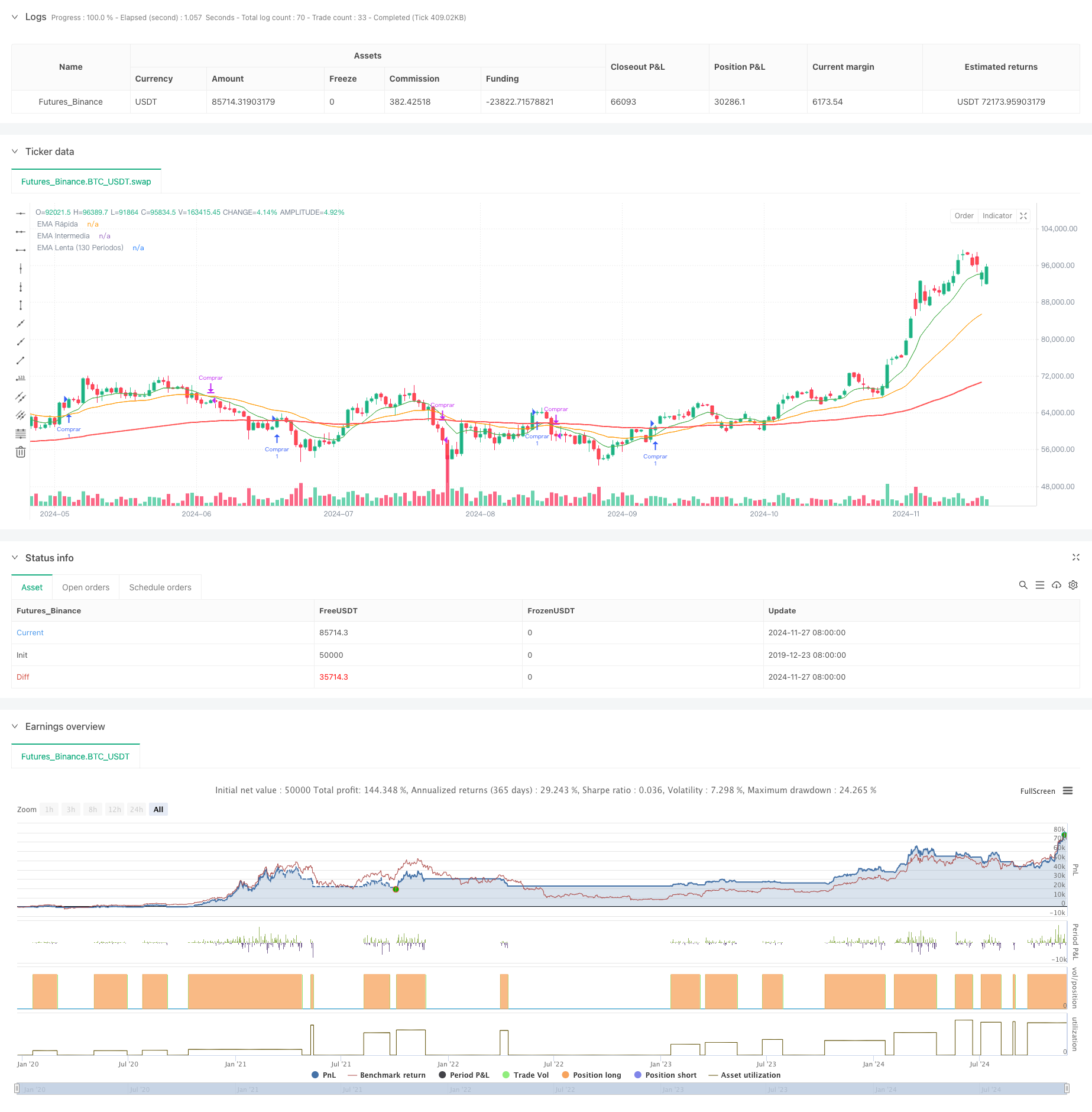Triple EMA Trend Following Quantitative Trading Strategy
Author: ChaoZhang, Date: 2024-11-29 16:54:41Tags: EMAMA

Overview
This strategy is a trend following system based on triple exponential moving averages (EMA). It captures market trends through crossover signals and trend direction confirmation using fast, intermediate, and slow EMAs, exclusively taking long positions in uptrends. The strategy implements strict stop-loss controls and backtesting validation mechanisms to achieve robust trading performance.
Strategy Principles
The strategy utilizes three EMAs with different periods: fast EMA (adjustable 3-20 periods), intermediate EMA (adjustable 21-60 periods), and slow EMA (fixed 130 periods). Trading signals are based on:
- Entry conditions: Fast EMA crosses above intermediate EMA with both intermediate and slow EMAs trending upward; or fast EMA crosses above slow EMA with slow EMA trending upward.
- Exit conditions: Fast EMA crosses below intermediate EMA.
- Risk control: Fixed 6% stop-loss.
- Trend confirmation: Calculated through slope analysis of intermediate and slow EMAs.
Strategy Advantages
- Multiple confirmation mechanism: Reduces false signals through triple EMA and trend slope confirmations.
- High flexibility: Adjustable periods for fast and intermediate EMAs for market-specific optimization.
- Comprehensive risk control: Fixed stop-loss percentage for strict single-trade risk management.
- Clear trend following: Ensures trading only in definitive uptrends through EMA slope analysis.
- Standardized execution: Clear trading rules suitable for programmatic implementation.
Strategy Risks
- Sideways market risk: May generate frequent false signals in ranging markets.
- Lag risk: Moving averages are inherently lagging indicators, potentially missing early trend opportunities.
- Parameter dependency: Optimal parameters may vary across different market environments.
- Stop-loss risk: Fixed stop-loss may lack flexibility in high-volatility environments.
- Trend reversal risk: Potential for significant losses during sudden trend reversals.
Strategy Optimization Directions
- Dynamic parameter optimization: Suggest adjusting EMA periods based on market volatility.
- Market environment filtering: Add trend strength indicators to avoid trading in weak trend environments.
- Stop-loss optimization: Consider incorporating volatility indicators like ATR for dynamic stop-loss adjustment.
- Position management: Implement dynamic position sizing based on market volatility.
- Exit optimization: Consider adding profit targets or trailing stop mechanisms.
Summary
This strategy represents a well-structured and logically rigorous trend following system. The combination of multiple technical indicators ensures both reliability and flexibility. While there is room for optimization, the overall framework provides a solid foundation for practical application. Traders are advised to thoroughly optimize parameters and conduct backtesting before live implementation, making specific adjustments based on market characteristics.
/*backtest
start: 2019-12-23 08:00:00
end: 2024-11-28 00:00:00
period: 1d
basePeriod: 1d
exchanges: [{"eid":"Futures_Binance","currency":"BTC_USDT"}]
*/
//@version=5
strategy("Estrategia de Largo con Medias Móviles", overlay=true)
// Parámetros ajustables de las medias móviles
fast_length = input.int(10, title="Período de Media Rápida", minval=3, maxval=20)
mid_length = input.int(30, title="Período de Media Intermedia", minval=21, maxval=60)
slow_length = input.int(130, title="Período de Media Lenta (EMA 130)", minval=130)
// Calcular las medias móviles
fast_ma = ta.ema(close, fast_length)
mid_ma = ta.ema(close, mid_length)
slow_ma = ta.ema(close, slow_length) // Media lenta exponencial de 130 periodos
// Calcular la pendiente manualmente (restando el valor actual de la media móvil del valor de 1 barra anterior)
slope_ma130 = slow_ma - slow_ma[1] // Pendiente de la media lenta
slope_mid_ma = mid_ma - mid_ma[1] // Pendiente de la media intermedia
// Condición para pendiente positiva de la media lenta
slow_ma_trending_up = slope_ma130 > 0
// Condición para pendiente positiva de la media intermedia
mid_ma_trending_up = slope_mid_ma > 0
// Condiciones para entrada en largo (Cruce de la media rápida sobre la media intermedia, solo si la media intermedia tiene pendiente positiva y la media lenta también tiene pendiente positiva)
long_condition = ta.crossover(fast_ma, mid_ma) and mid_ma_trending_up and slow_ma_trending_up
// Condiciones para entrada adicional (Cruce de la media rápida sobre la media lenta, solo si la media lenta tiene pendiente positiva)
additional_long_condition = ta.crossover(fast_ma, slow_ma) and slow_ma_trending_up
// Condiciones para cierre de la posición (Cruce de la media rápida por debajo de la media intermedia)
exit_condition = ta.crossunder(fast_ma, mid_ma)
// Abrir la posición si se cumplen las condiciones (incluyendo las pendientes de las medias)
if (long_condition or additional_long_condition)
strategy.entry("Comprar", strategy.long)
// Cerrar la posición si se cumplen las condiciones de salida
if (exit_condition)
strategy.close("Comprar")
// Mostrar las medias móviles en el gráfico
plot(fast_ma, color=color.green, linewidth=1, title="EMA Rápida")
plot(mid_ma, color=color.orange, linewidth=1, title="EMA Intermedia")
plot(slow_ma, color=color.red, linewidth=2, title="EMA Lenta (130 Periodos)")
- Cross-Market Overnight Position Strategy with EMA Filter
- MACD Crossover Strategy
- G-Channel and EMA Trend Filter Trading System
- Dual Chain Hybrid Momentum EMA Tracking Trading System
- Multi-EMA Crossover Trend Following Strategy
- Triple EMA Crossover Trading Strategy with Dynamic Stop-Loss and Take-Profit
- Multi-Timeframe EMA Trend Strategy with Daily High-Low Breakout System
- Intraday Breakout Strategy Based on 3-Minute Candle High Low Points
- EMA Momentum Trading Strategy
- Multi-EMA Crossover Momentum Trend Following Strategy
- Bollinger Bands High-Frequency Quantitative Strategy Combined with High-Low Breakout System
- MACD-RSI Dynamic Crossover Quantitative Trading System
- RSI and Supertrend Trend-Following Adaptive Volatility Strategy
- Dual EMA Crossover with RSI Momentum Enhanced Trading Strategy
- Multi-Technical Indicator Trend Following Trading Strategy
- Multi-Exponential Moving Average Crossover Strategy with Volume-Based ATR Dynamic Stop-Loss Optimization
- Dual Chain Hybrid Momentum EMA Tracking Trading System
- Dynamic Signal Line Trend Following and Volatility Filtering Strategy
- Multi-Timeframe Bollinger Momentum Breakout Strategy with Hull Moving Average
- Multi-Step Volatility-Adjusted Dynamic SuperTrend Strategy
- Dual Hull Moving Average Crossover Quantitative Strategy
- Statistical Deviation-Based Market Extreme Drawdown Strategy
- Four-Period SMA Breakthrough Trading Strategy with Dynamic Profit/Loss Management System
- RSI and Bollinger Bands Cross-Regression Dual Strategy
- Multi-Wave Trend Following Price Analysis Strategy
- Smoothed Heikin-Ashi with SMA Crossover Trend Following Strategy
- Reflected EMA Trend Determination Strategy Based on Hull Moving Averages
- Dual EMA Indicator Smart Crossing Trading System with Dynamic Stop-Loss and Take-Profit Strategy
- OBV-SMA Crossover with RSI Filter Multi-Dimensional Momentum Trading Strategy
- Dynamic Volatility Trading Strategy Based on Bollinger Bands and Candlestick Patterns